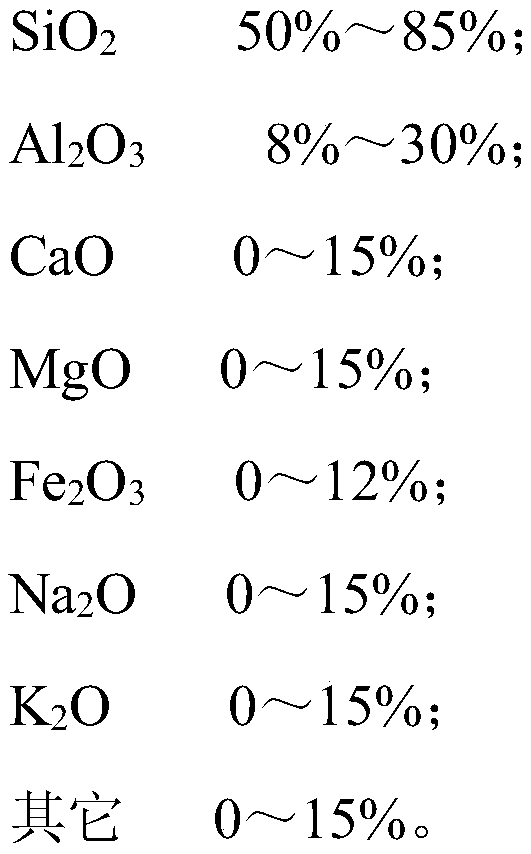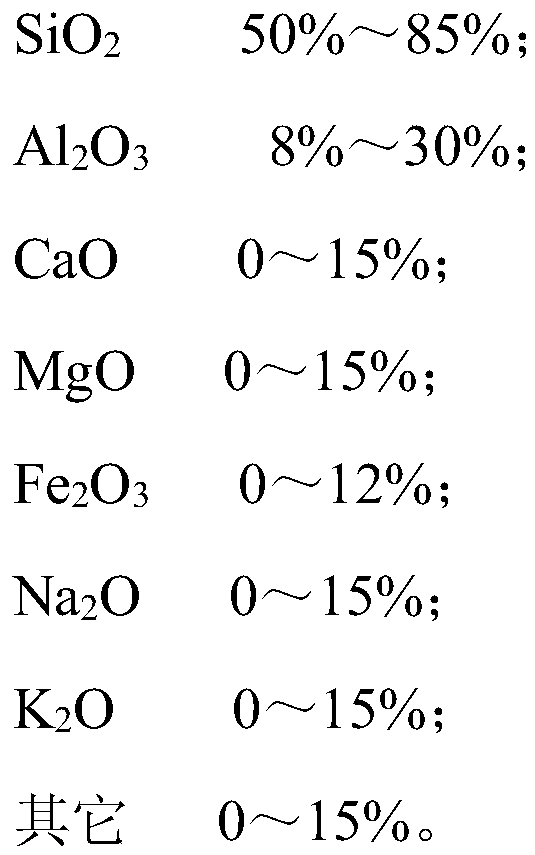Artificial lightweight material and preparation method and application thereof
A lightweight material, artificial technology, applied in the field of building materials, can solve the problems of shortage of high-quality materials, low thermal conductivity, large specific gravity, etc., to achieve the effects of environmental protection, wide range of uses, and low water absorption
- Summary
- Abstract
- Description
- Claims
- Application Information
AI Technical Summary
Problems solved by technology
Method used
Image
Examples
Embodiment 1
[0033] The raw material ratio and raw material chemical composition of artificial lightweight materials are shown in Table 1:
[0034] Table 1 Raw material ratio and chemical composition of artificial lightweight material 1
[0035]
[0036] The artificial lightweight material is prepared according to the following steps:
[0037] 1. Select the raw materials shown in Table 1.
[0038] 2. Mix the raw materials selected in step 1 according to the proportion shown in Table 1, grind them in a ball mill, pass through a 300-mesh sieve, and control the sieve residue to be less than 10%, so as to obtain raw meal powder.
[0039] 3. Stamping the raw meal powder prepared in step 2.
[0040] 4. Sinter the shaped raw meal prepared in step 3 in a tunnel kiln, set the maximum firing temperature to 1200°C, and the heating rate to 15°C / min.
[0041] 5. Naturally cool the material obtained in step 4 to obtain artificial lightweight material 1.
[0042] 6. Cut the artificial lightweight ...
Embodiment 2
[0044] The raw material ratio and raw material chemical composition of artificial lightweight materials are shown in Table 2:
[0045] Table 2 Raw material ratio and chemical composition of artificial lightweight material 2
[0046]
[0047] The artificial lightweight material is prepared according to the following steps:
[0048] 1. Select the raw materials shown in Table 2.
[0049] 2. Mix the raw materials selected in step 1 according to the proportion shown in Table 1, grind them in a ball mill, pass through a 300-mesh sieve, and control the sieve residue to be less than 10%, so as to obtain raw meal powder.
[0050] 3. Extrude the raw meal powder prepared in step 2.
[0051] 4. The shaped raw meal prepared in step 3 is sintered in a roller kiln, the maximum firing temperature is set to 1200° C., and the heating rate is 15° C. / min.
[0052] 5. Naturally cool the material obtained in step 4 to obtain the artificial lightweight material 2.
[0053] 6. Cut the artifici...
Embodiment 3
[0055] The raw material ratio and raw material chemical composition of artificial lightweight materials are shown in Table 3:
[0056] Table 3 Raw material ratio and chemical composition of artificial lightweight material 3
[0057]
[0058] The artificial lightweight material is prepared according to the following steps:
[0059] 1. Select the raw materials shown in Table 3.
[0060] 2. Mix the raw materials selected in step 1 according to the proportion shown in Table 1, grind them in a ball mill, pass through a 300-mesh sieve, and control the sieve residue to be less than 10%, so as to obtain raw meal powder.
[0061] 3. Extrude the raw meal powder prepared in step 2.
[0062] 4. Sinter the shaped raw meal prepared in step 3 in a 1m3 shuttle kiln, set the maximum firing temperature to 1180°C, and the heating rate to 18°C / min.
[0063] 5. Naturally cool the material obtained in step 4 to obtain artificial lightweight material 3.
[0064] 6. Crushing and screening the ar...
PUM
 Login to View More
Login to View More Abstract
Description
Claims
Application Information
 Login to View More
Login to View More - Generate Ideas
- Intellectual Property
- Life Sciences
- Materials
- Tech Scout
- Unparalleled Data Quality
- Higher Quality Content
- 60% Fewer Hallucinations
Browse by: Latest US Patents, China's latest patents, Technical Efficacy Thesaurus, Application Domain, Technology Topic, Popular Technical Reports.
© 2025 PatSnap. All rights reserved.Legal|Privacy policy|Modern Slavery Act Transparency Statement|Sitemap|About US| Contact US: help@patsnap.com



